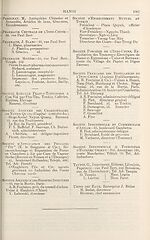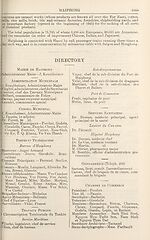1926
(1151) [Page 1088] - Haiphong
Download files
Complete book:
Individual page:
Thumbnail gallery: Grid view | List view
![(1151) [Page 1088] - Haiphong](https://deriv.nls.uk/dcn17/1965/0313/196503138.17.jpg)
HAIPHONG
Haiphong, the commercial capital of Tonkin, is built on the right bank of the riv( H
"Cua Cam, one of the numerous divisions of the Song Khoi (Red River), which connec
Yunnan with the Tonkin Gulf. Its geographical situation is 20 deg. 51 min. lat. li
106 deg. 42 min. long. E. Although the river is somewhat obstructed by a bar, tl
entrance to the harbour is as accessible by night as it is by day, thanks to an up-t<
date system of lights. The channel, constantly dredged and supervised by the Depi
of Public Works, allows the biggest liners of the Messageries Maritimes to call at Had
phong. The lighthouse on the island of Hondau shows a light visible 20 naval mi'd
distant, while that on the Norway islands, indicating the entrance to Hongay, th
coaling station, is visible at 25 miles. Vessels anchor in front of the city, in the rniddl
of the river, a quarter-of-a-mile from the shore, while a wharf of 2,000 feet gives amplj
•space for tl*e accommodation of five big ocean-going liners at one time. This wharf i
equipped with all modern appliances—2-ton electric cranes, 10-and 20-ton steam cranes
rail track, and electric light. Ships arriving alongside may be immediately connecte<
with the telephone and thus get in touch with any point in the city. Large ward
houses, covering an area of 9 acres and having a storage capacity of 100,000 tons, have
been erected on the water-front and are connected by rail with the Central Static*
of the Compagnie des Chemins de Fer de ITndo-Chine et du Yunnan. There is thus every
. facility for the quick handling of goods destined for the diflerent centres of Tonkir
and the Chinese province of Yunnan, to which Haiphong is the gateway, by means oj
the railway line. These godowns and the wharf are the property of the Chamber of!
Commerce, which owns also the s.s. Amiral de Beaumont, a powerful sea going tug ready
to give assistance to any vessel, whether at sea or in the harbour. A floating dock,
capable of lifting vessels up to 330 feet in length and 2,500 tons displacement, is
^attached to a modern shipbuilding and repairing yard, where the most extensive
repairs can be undertaken.
Haiphong proper is in the midst of an extensive rice swamp with low-lying swampy
land all around it for miles, having in the distance the monotony relieved by rugged
ranges of low limestone hills, and beyond these to the northward, at a distance
of some 16 miles, is a range of mountains, the loftiest, known as the Grand
Summit, being about 5,000 feet high. Though at the time of its origin in 1884 Hai¬
phong was but a mere native village in the midst of rice fields and muddy streams,, it
has rapidly developed into the most important commercial and industrial centre
of T'onkin and the port for all home and foreign traffic. Being a new town, it
has been built according to modern ideas. The streets and boulevards are wide, clean
and well-shaded, and constructed for the most part at right angles. The town
has a cosy and pleasing appearance, most of the houses being of the cottage type. The
chief commercial and administrative buildings are the Central Rost Office, City
Hall, Banque Industrielle, Municipal Theatre, and Custom-house. There is a Roman
Catholic Cathedral attached to the Spanish Mission, and a Protestant church, also,
has been erected in the town. There is a very pretty theatre, built in 1900 by the
Municipality. The Hotel du Commerce is a large and handsome structure, its lofty
mansard roof dominating every building in the town. The Cercle du Commerce,!
which is a well-managed club, has its domicile in the boulevard Paul Bert. The
racecourse is about a mile from the town on the Do Son Road. The year 1922 saw
the opening of the “ Cercle Sportif Haiphonnais,” with a large and handsome building
and extensive grounds for all forms of sport.
Haiphong has two public gardens, where military concerts are given on Sundays
and Thursdays. The small Botanical Garden of the Lach Tray, two miles out of town,
is one of the evening promenades.
The appearance of this city, agreeably disposed among trees and tropical vegeta¬
tion, appeals to the eye of the traveller arriving by sea on a sunny day.
The city, originally comprised within the Cua-Cam and Song-Tarn Bac rivers and
the Bonnal canal, soon spread beyond these narrow'limits owing to the development
of its commerce and industry, foreign and indigenous. The principal industrial
Haiphong, the commercial capital of Tonkin, is built on the right bank of the riv( H
"Cua Cam, one of the numerous divisions of the Song Khoi (Red River), which connec
Yunnan with the Tonkin Gulf. Its geographical situation is 20 deg. 51 min. lat. li
106 deg. 42 min. long. E. Although the river is somewhat obstructed by a bar, tl
entrance to the harbour is as accessible by night as it is by day, thanks to an up-t<
date system of lights. The channel, constantly dredged and supervised by the Depi
of Public Works, allows the biggest liners of the Messageries Maritimes to call at Had
phong. The lighthouse on the island of Hondau shows a light visible 20 naval mi'd
distant, while that on the Norway islands, indicating the entrance to Hongay, th
coaling station, is visible at 25 miles. Vessels anchor in front of the city, in the rniddl
of the river, a quarter-of-a-mile from the shore, while a wharf of 2,000 feet gives amplj
•space for tl*e accommodation of five big ocean-going liners at one time. This wharf i
equipped with all modern appliances—2-ton electric cranes, 10-and 20-ton steam cranes
rail track, and electric light. Ships arriving alongside may be immediately connecte<
with the telephone and thus get in touch with any point in the city. Large ward
houses, covering an area of 9 acres and having a storage capacity of 100,000 tons, have
been erected on the water-front and are connected by rail with the Central Static*
of the Compagnie des Chemins de Fer de ITndo-Chine et du Yunnan. There is thus every
. facility for the quick handling of goods destined for the diflerent centres of Tonkir
and the Chinese province of Yunnan, to which Haiphong is the gateway, by means oj
the railway line. These godowns and the wharf are the property of the Chamber of!
Commerce, which owns also the s.s. Amiral de Beaumont, a powerful sea going tug ready
to give assistance to any vessel, whether at sea or in the harbour. A floating dock,
capable of lifting vessels up to 330 feet in length and 2,500 tons displacement, is
^attached to a modern shipbuilding and repairing yard, where the most extensive
repairs can be undertaken.
Haiphong proper is in the midst of an extensive rice swamp with low-lying swampy
land all around it for miles, having in the distance the monotony relieved by rugged
ranges of low limestone hills, and beyond these to the northward, at a distance
of some 16 miles, is a range of mountains, the loftiest, known as the Grand
Summit, being about 5,000 feet high. Though at the time of its origin in 1884 Hai¬
phong was but a mere native village in the midst of rice fields and muddy streams,, it
has rapidly developed into the most important commercial and industrial centre
of T'onkin and the port for all home and foreign traffic. Being a new town, it
has been built according to modern ideas. The streets and boulevards are wide, clean
and well-shaded, and constructed for the most part at right angles. The town
has a cosy and pleasing appearance, most of the houses being of the cottage type. The
chief commercial and administrative buildings are the Central Rost Office, City
Hall, Banque Industrielle, Municipal Theatre, and Custom-house. There is a Roman
Catholic Cathedral attached to the Spanish Mission, and a Protestant church, also,
has been erected in the town. There is a very pretty theatre, built in 1900 by the
Municipality. The Hotel du Commerce is a large and handsome structure, its lofty
mansard roof dominating every building in the town. The Cercle du Commerce,!
which is a well-managed club, has its domicile in the boulevard Paul Bert. The
racecourse is about a mile from the town on the Do Son Road. The year 1922 saw
the opening of the “ Cercle Sportif Haiphonnais,” with a large and handsome building
and extensive grounds for all forms of sport.
Haiphong has two public gardens, where military concerts are given on Sundays
and Thursdays. The small Botanical Garden of the Lach Tray, two miles out of town,
is one of the evening promenades.
The appearance of this city, agreeably disposed among trees and tropical vegeta¬
tion, appeals to the eye of the traveller arriving by sea on a sunny day.
The city, originally comprised within the Cua-Cam and Song-Tarn Bac rivers and
the Bonnal canal, soon spread beyond these narrow'limits owing to the development
of its commerce and industry, foreign and indigenous. The principal industrial
Set display mode to:
![]() Universal Viewer |
Universal Viewer | ![]() Mirador |
Large image | Transcription
Mirador |
Large image | Transcription
Images and transcriptions on this page, including medium image downloads, may be used under the Creative Commons Attribution 4.0 International Licence unless otherwise stated. ![]()
| Asian directories and chronicles > 1926 > (1151) [Page 1088] - Haiphong |
|---|
| Permanent URL | https://digital.nls.uk/196503136 |
|---|
| Attribution and copyright: |
|
|---|---|
| Description | Volumes from the Asian 'Directory and Chronicle' series covering 1917-1941, but missing 1919 and 1923. Compiled annually from a multiplicity of local sources and research. They provide listings of each country's active corporations, foreign residents and government agencies of all nationalities for that year, together with their addresses. Content includes: various treaties; coverage of conflicts; currencies and taxes; consular fees; weights and measures; public holidays; festivals and traditions. A source of information for both Western states and communities of foreigners living in Asia. Published by Hongkong Daily Press. |
|---|---|
| Shelfmark | H3.86.1303 |
| Additional NLS resources: |

